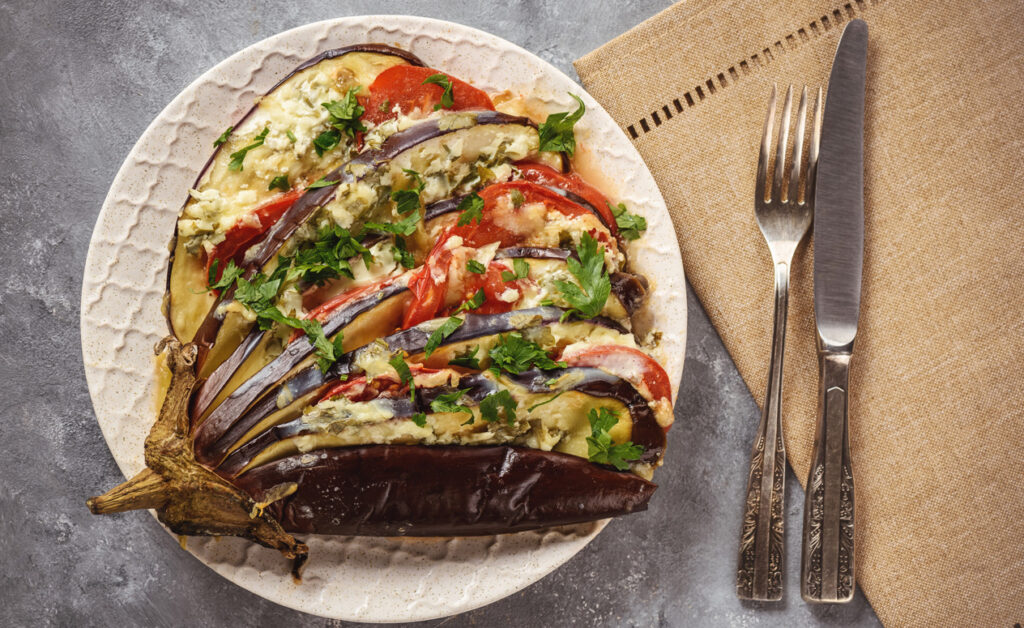With mozzarella, tomatoes and parsley.
Indulge in the rich, smoky flavors of this Mediterranean-inspired roasted eggplant. It features this harmonious blend of flavors – where the creamy richness of mozzarella melds with the juicy sweetness of tomatoes – and then accented by the bright freshness of parsley.

This roasted eggplant with mozzarella and tomato is more than just a meal; it’s a journey through flavor and tradition. Embrace the simplicity of this dish and let the natural goodness of fresh ingredients take the spotlight.
Skill Level: Intermediate
While the recipe is straightforward, it requires careful slicing and attention to roasting times to ensure the eggplant is cooked to perfection.
Healthy Attributes:
Eggplant is a great source of dietary fiber and antioxidants. Coupled with the lycopene from tomatoes and protein from mozzarella, this dish is as nutritious as it is delicious.
Roasted Eggplant Recipe
Prep/Cooking Time: 45 minutes
Ingredients:
- 1 large eggplant (approx. 1 lb or 450g), stem on
- 8 oz (225g) fresh mozzarella cheese, sliced
- 2 medium tomatoes, sliced
- A handful of fresh parsley, chopped
- 2 tablespoons olive oil (30ml)
- Salt and pepper to taste
Instructions:
- Preheat your oven to 400°F (200°C).
- Rinse the eggplant and pat dry. Slice the eggplant lengthwise into 1/2 inch thick slices, ensuring they remain attached at the stem. (See tips about the skin below.)
- Brush each eggplant slice with olive oil and season with salt and pepper.
- Roast in the preheated oven for 20 minutes, or until the eggplant begins to soften. (See the correct pan to use for the roasting just below.)
- Remove from the oven and layer with mozzarella cheese and tomato slices.
- Return to the oven and roast for an additional 10-15 minutes, or until the cheese is bubbly and golden.
- Garnish with fresh parsley before serving.
The Right Pan for Roasted Eggplant
For roasting vegetables like eggplant, it’s best to use a heavy-duty baking sheet or a shallow roasting pan.
Here are a few characteristics to look for:
- Material: A pan made of heavy-gauge metal, such as stainless steel or aluminum, is ideal as it conducts heat well and roasts the vegetables evenly.
- Size: Choose a pan that is large enough to lay out the eggplant slices in a single layer without overcrowding. This ensures that each slice roasts properly rather than steams.
- Rimmed Edges: A pan with low sides is preferable to a deep roasting pan because it allows the heat to circulate around the eggplant, browning it nicely. However, the edges should be rimmed to keep any juices from dripping off the pan and into your oven.
- Non-stick Surface: While not essential, a non-stick surface can help prevent sticking and make cleanup easier. If you don’t have a non-stick pan, lining your pan with parchment paper or a silicone baking mat can be a good alternative.
- Oven-Safe: Ensure that the pan is oven-safe up to at least 425°F (220°C) since you’ll be roasting the vegetables at high temperatures.
If you are using a standard baking sheet and are concerned about the eggplant sticking, you can brush the pan lightly with olive oil or use a non-stick cooking spray in addition to lining it with parchment paper.
This will also help to achieve a nice caramelization on the bottom of the eggplant slices.
Tips for Perfection:
- Choose an eggplant that is firm and heavy for its size. This indicates freshness and ensures less bitterness.
- After slicing, generously salt the eggplant slices and let them rest for about 15-20 minutes.
This will help draw out moisture and reduce bitterness.
Rinse the slices to remove excess salt, and then pat them thoroughly dry with paper towels before proceeding with the roasting.
This extra step ensures a concentrated flavor and a desirable roasted texture.
Tips for the Skin of the Roasted Eggplant
The skin of larger eggplants can be tougher than that of smaller, younger ones. However, roasting the eggplant tends to soften the skin, making it more palatable and easier to eat.
If you’re concerned about the skin being too tough, there are a couple of steps you can take:
- Score the Skin: Before roasting, you can make shallow cuts in the skin of the eggplant. This can help the heat penetrate more easily and cook the skin more thoroughly.
- Longer Cooking Time: Adjusting the roasting time can also help. Roasting the eggplant for a longer period at a slightly lower temperature can soften the skin without burning the flesh.
- Peeling: If you prefer, you can partially peel the eggplant in stripes before slicing and roasting. This way, you get some of the textures and flavors of the skin, but in a more manageable amount.
- Selection: When choosing eggplants, select ones with smooth, shiny skin, which is a sign that the eggplant is fresher and the skin may be more tender.
Remember that the skin contains a good amount of nutrients, so it’s beneficial to consume it if possible.
Optional Ingredients:
- A drizzle of balsamic glaze
- Crushed garlic or garlic powder
- A sprinkle of Parmesan cheese
Serving Suggestions:
Pair this dish with a crisp green salad, quinoa, or crusty bread to absorb the delicious juices.
Nutrient Information:
Approximate per serving: 250 calories, 10g protein, 15g fat, 20g carbohydrates, 7g fiber.
Storage and Reheating:
Store in an airtight container in the refrigerator for up to 3 days. Reheat in the oven until warm throughout.
Origin and Folklore:
Eggplant, a staple in Mediterranean cuisine, has been celebrated for centuries in stories and songs for its versatility. This recipe pays homage to traditional methods of roasting vegetables, allowing their natural flavors to shine.
This dish is a testament to the delights of simple, yet thoughtfully combined, ingredients.
We also have these eggplant recipes for you to try!
Enjoy your culinary creation!
.
[amazon bestseller=”shallow roasting pan” items=”3″]